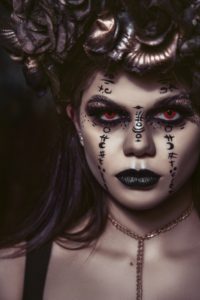Does the historic misunderstanding of mental illness and our celebration of Halloween have anything in common?
I began to wonder about the connection between mental illness and Halloween at a recent comm 
unity activity I attended celebrating the holiday. At the event actors were mingling among the participants in bizarre scary costumes. But what frightened me most were the offbeat personality characteristics the actors portrayed.
In their attempt to instill fear, the characters were eerily making eye contact by either overtly staring at the crowd or not looking at any one directly. In addition they were invading people’s personal space, making socially clueless noises and using bizarre body movements and gestures. As a mental health therapist, I recognized these mannerisms, although extreme, as similar to those on the autism spectrum. The three core symptoms of Autism as recognized by the DSM, a Diagnostic Manual are impairment in social interaction, impairment in communication and repetitive behaviors and fixated interests.
In layman terms, someone with autism or autistic tendencies appears “odd.” Imagine in bygone days an unmarried “odd” person living alone with rotten teeth, dirty hair and little social awareness skills. Picture them on the outskirts of a town or village in a neglected run down house. Now imagine meeting these characters on a dark night with a full moon in the background casting an eerie shadow and the wolves howling in the background. In that scene, even the bravest among us would feel a chill down their spine. Besides autism, all mental health disorders can seem strange and frightening.
Without education and understanding, conditions such as depression, anxiety, paranoia, mood instability and schizophrenia can all look like something out of a bad horror movie. Until the late 1990’s the Utah Mental Health Hospital ran a “Haunted House” during the Halloween season using the actual mental patients of the hospital as participants. The practice was eventually discontinued but many residents of Provo including some former BYU students still remember the event as “the best haunted house ever.”
Since it is common for us to fear the unknown and misunderstood, ancient cultures attempted to alleviate anxiety by dramatizing or mimicking what was feared. Perhaps long ago we began to tell our children stories about haunted people and their bizarre behaviors in an attempt to help us feel control over those who seemed alien and out of this world. Gradually our culture evolved to some of the traditions surrounding our modern day Halloween. Halloween can be an enjoyable holiday but about 6 percent, or 1 in 17 Americans suffer from a serious mental illness.
It is estimated that mental illness affects 1 in 5 families in America. 1 out of 15 adults will suffer some kind of mental illness in their lifetime. Utah, Arkansas, Rhode Island and West Virginia have one of the highest rates in the US for people suffering from both a serious mental illness and any mental illness. The “trick” behind mental illness is that it is NOT a result of personal weakness, lack of character or poor upbringing. The “treat” is that mental illness is treatable. Knowledge about diagnosis and effective treatment can bring our society out of the dark ages and give dignity to all who suffer.
You may want to read more about bi polar disorder here: https://provocounselingcenter.net/concerns/bi-polar/
Another good post on good mental health:
CAMILLE CURTIS FOSTER LCSW

Sources: NAMI Utah website, retrieved 10/26/11 quoting the NSDUH Report Also published on KSL.com 10/31/2011 http://www.ksl.com/?nid=968&sid=17846980
A religious leader speaks out defending those with mental illness: http://www.lds.org/general-conference/watch/2013/10?lang=eng&vid=2722351290001&cid=10
Photo by Dima Valkov from Pexels
